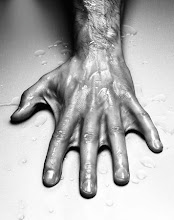For the détrempe
55g fresh baker's yeast (or 40g if rising overnight, see notes below)
500g white bread flour
500g ordinary plain flour
150g butter, melted
120g sugar
25g salt
590g whole milk
For the beurrage
500g butter
Notes on ingredients
We never work with dried/easy-blend yeast so I don't want to give advice on how to go about it. It should be possible to substitute easy-blend yeast without too much hassle and no doubt some noggin has written about it on the Internet elsewhere. You could always go to your local baker's and ask for some yeast, but they might be a bit peeved!
If preparing the dough the night before, use 40g.
The bread flour is used because it will provide more gluten to the dough which will help it rise. However, to avoid overdoing it, ordinary flour makes up the other half.
I suggest weighing the ingredients directly into the bowl of your mixer in the order listed. This means the yeast will be covered by the flour to precent it drying out, and it won't come into contact with the salt which risks killing it.
As with the inverted puff pastry, I would recommend shooting with a half quantity. I would also strongly recommend getting the hang of puff pastry and all the rolling out before taking on the croissant dough. The croissant dough is quite a bit tougher on the rolling out front due to the higher levels of gluten.
Method
1. Slowly combine the ingredients in a mixer with the dough hook. Once combined, turn up the speed to medium until the dough comes cleanly away from the sides of the bowl.
- You can hold some of the milk back and add it at the end on checking the consistency of the dough. Problem is, if you're on your own and not sure of your target texture, there's little point.
- You're probably a bit loopy if you want to do this by hand. I never have, but just follow your usual dough-working procedures... combine everything together at fingertips or with a scraper then turn out the dough and work until smooth and elastic.
2. Transfer to a plastic bowl covered with cling film and either leave at room temperature for 60-90mins, knock back then pop, still covered, into the fridge overnight or let rise for 45mins at 25°C, knock back, then spread on an oven tray (c.2cms thick) and leave covered in the fridge until well chilled.
- We use a proving chamber for these rising periods which helps control temperature. Domestic alternatives are stretching the scope of this little post but ideas include a turned off microwave or a polystyrene box, heated with a bowl of boiling water. Some people go with the airing cupboard -- but this risks being even too hot and drying out the dough.
3. In either case it is now time to move on to the beurrage. Whip the butter out of the fridge and soften it by walloping with a rolling pin in a an acrylic or silicon sheet. This gives you a chance to shape the butter into a square (c. 20 x 20cm for a half quantity) and to soften it while keeping it cold. Roll out the détrempe to c. 40 x 20cm and pop the butter on top.
- A crucial point is to seek the same texture between the butter and the détrempe. If they are significantly different, you risk marbling the pastry and not having distinct butter-détrempe layers. If the butter is too hard, bash it more with a rolling pin. If the dough is too soft, pop it back in the fridge/freezer for a bit.
4. Then you need to follow steps 2,3 and 4 here. Which amounts to a tour d'incorporation immediately followed by a tour double, resting until well chilled, a tour simple, resting until well chilled, then rolling out and chilling. Takes some time, especially without a blast chiller.
- Aiming for 50 x 60cm when finally rolled out (with a half quantity). It is easier if you cut the dough in half and do this in two stages. It is quite thin. You may well need to chill the dough during the process. The warmer the dough gets, the more elastic the gluten and the more frustrating the endeavour becomes.
5. Proceed as per the first croissant post here. The proving is done after the first glaze at 25-30°C. The proving space needs to be get humid to prevent a crust forming on the croissants. This is done with a bowl of boiling water in the proving space. It should take about 90mins.
- At each of the stages of fermentation it is hard to know how long to leave the dough the first few times you try. The classic rule is 'until the dough looks like it has nearly doubled in volume'. At this final stage you want the dough to be quite loose/baggy - so if you prod it gently, it doesn't spring back to its original shape.
- Glaze lovingly with beaten eggs. Most people say to add a pinch of salt since this helps break down the egg proteins - since we use liquid egg in the first place, no need.
6. After glazing for a second time, pop in the oven at 190°C and cook until golden. Transfer to drying rack &c.
PS Croissant making is not one of the easiest things to get off a blog. Regular readers will know about my early struggles and that was using professional equipment and with a teacher in the room. Further, I don't think I've been particularly eloquent and I've rather rushed it. Sorry. Still... any questions or doubts, pop me an email/comment.














